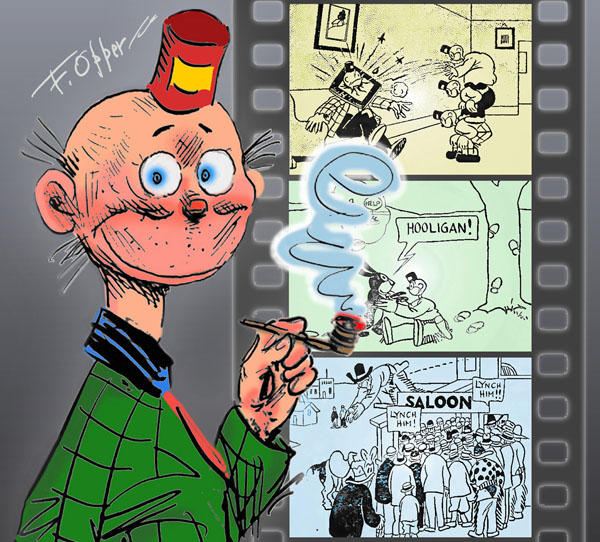
One thing that surprised me during my investigation of the animated adventures of Happy Hooligan, for my latest Cartoon Research book, was that the character wasn’t just famous – he was incredibly popular. I distinguish the two identifiers. Something can be “famous” without being “popular.” The tramp with the empty tomato can on his head was extremely popular.

Frederick Burr Opper
Opper brought Happy to Vitagraph Studios for the production of live-action, comedy shorts the same year his comic strip debuted. The first film appeared that fall. Twenty-three were produced through 1903.
Happy Hooligan merchandise flooded the market. Before the term “action figure” was coined, Happy Hooligan was one, in 1906. The tramp took to the stage, also, touring vaudeville under the direction of producer Gus Hill.
Happy made his debut in an animated cartoon on October 9th, 1916, via Hearst’s International Film Service animation studio. The key Hooligan cartoon players were producer Gregory La Cava, animator William Nolan, writer Louis De Lorme, and series illustrators Jack King and Walter Lantz. Frederick Opper contributed story ideas.
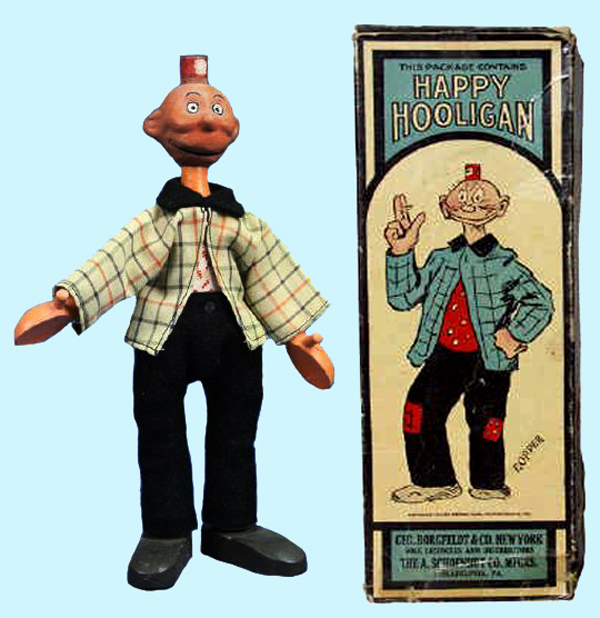
There is little doubt that the cartoons were a big hit when you read reviews and theater patron comments. This was due to International’s high-quality, animation standards and comedic cleverness of the stories. Hearst hired the best, and the material reflects that.
However, a political and financial mess lurked behind the cartoons, as well as a hostile workplace, due to the relentless production pace. IFS animator Bert Green stated in a May 1919 interview, “It’s no use making any engagements while in this business, as you might as well be serving a sentence in Joliet.”
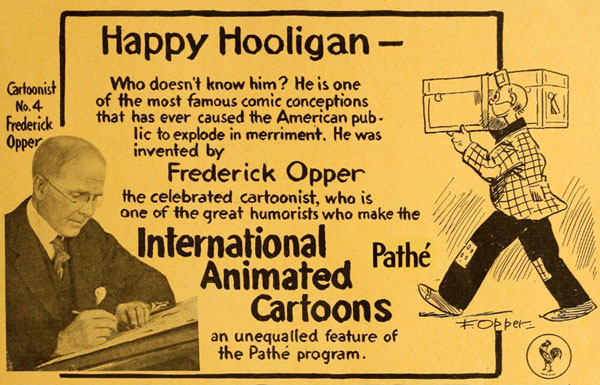
On July 6th, 1918, the IFS animation studio experienced a complete meltdown. It was called “Black Monday.” They laid off their entire staff due to financial difficulties. There were two main causes: Hearst’s pro-Germany, anti-war/anti-British position in the newspapers when the war broke out and the Spanish flu.
The influenza pandemic waves were a big hit to IFS. It’s difficult to go to a theater when they are closed due to health hazard, or lack of patrons, or when the government is urging folks “to stay home.”
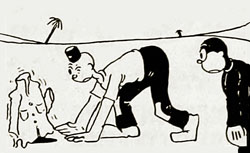
Art from the Happy Hooligan cartoon “The Tail of a Shirt” (1919)
“Up to the time of the outbreak of the Spanish influenza, we had been distributing International’s animated cartoons with great success,” EFC president, Earle W. Hammons, said in an interview. “But when the situation reached a critical stage, Educational ceased releasing these cartoons, and subsequently the International Film Service stopped making them.”
IFS general manager, Carl E. Zittel, conveyed that the studio was, “thoroughly demoralized by the influenza [pandemic] and the demands for military service.”
The state of New York suffered 41,000 deaths due to influenza between 1918-20. The number of the sick that survived was astronomical.
The politics of Hearst, the spread of influenza, the suspension of distribution, and the disruption of wartime created the perfect storm for the failure of IFS. Hearst had to downsize, and IFS was among his least profitable ventures.
 By the end of 1918 he was steadily rebuilding the studio. It was up and running, and releasing cartoons again, by March 1919. Educational returned as its distributor, but not for long.
By the end of 1918 he was steadily rebuilding the studio. It was up and running, and releasing cartoons again, by March 1919. Educational returned as its distributor, but not for long.
In the fall of 1919, Hearst leased the IFS comic strip based cartoon titles to Goldwyn-Bray. In short order, distributor Goldwyn bought controlling interest in Bray Pictures, essentially owning the company John R. Bray had built. But Hearst hadn’t revealed his cartoons were becoming unprofitable when signing the lease, so only months into the agreement Bray owed IFS over $41,000.
Perfect storm number two unfolded. The result: there were breaches of contract and lease, and also non-payment of earnings. Lawsuits flew back and forth. Employees sued both sides, as well.
In the center of the storms was Happy Hooligan. Goldwyn-Bray, with product coming out of the IFS studio, released their first Hooligan cartoon on April 17th, 1920. Leading into the following year, the quality of the animated shorts diminished. By the time the final “Bray” Hooligan cartoon was released on April 23, 1922, folks had lost interest in the tramp topped with an empty tomato can.
As many as 55 Happy Hooligan cartoons were released over five and a half years. While only a few of the cartoons exist today to enjoy, there can be little doubt – the series was wildly popular. Hopefully, more films will be uncovered. I hope you’ll check out my new book for much, much more information.
Order the New Cartoon Research Book
“Happy Hooligan: The Animated Cartoons 1916-1922”
Now Available on Amazon.











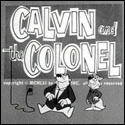





























The link to the book will be posted soon, so check back.
Seems to me Grim Natwick’s first job in animation was working on a Happy Hooligan cartoon.
happy is mentioned a few times by ward in at least 2 episodes of “leave it to beaver”.
In a 30’s series of Barney Google comic strips Barney is hired by a newspaper to write comics. He creates a Happy Hooligan-esc character named “Homeless Heinie.” (Not sure of the spelling; forgive me.)
Happy Hooligan, the Katzenjammer Kids, & Alphonse & Gaston appeared in each others’ strips; perhaps they’re the 1st cartoon shared universe?
Never seen HH before, but he kinda spooks me in that old-timey way.
I believe it was Grim Natwick’s first animation job. From the book:
“Artist Grim Natwick was recruited by Gregory La Cava to temporarily fill an animation position until an experienced talent could be secured. His first assignment was a horse race sequence in a Happy Hooligan cartoon. William Randolph Hearst was so impressed with Natwick’s work, he offered him $100 per week to remain on staff.”
So, he was supposed to be a “temp,” but ended up full-time plus.
Jules Feiffer caricatured Gerald Ford as Happy, placing a little tin can labeled “WIN” (“Whip Inflation Now”) on his head.
Feiffer remembered Happy as a hapless, cheerful idiot; those were the qualities he attributed to Ford.